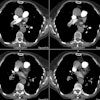J Thorac Imaging 1997 Apr;12(2):128-149. Helical CT angiography of the thoracic aorta.
Rubin GD
Five years after its introduction (11,36), spiral or helical CTA is being embraced as an important noninvasive tool for imaging the thoracic aorta and its branches. The high degree of accessibility and ease with which the studies are performed make it a viable alternative to aortography in the acute setting. Once the examiner is familiar with the principles of CTA, the acquisition phase of the examination can be completed in as little as 15 minutes, but it is critical that a thorough understanding of these principles guide the radiologist to maximize information gained by the technique. Several important challenges remain for CTA. First, the proliferation of image-processing workstations and software is improving our ability to exploit these CT data by allowing us to visualize them in novel ways (37) and create alternative renderings with greater ease and speed. Before relying on these alternative visualization techniques, their accuracy and pitfalls, and the incremental gain they achieve over interpretation of the primary transverse sections must be fully established. This requires that carefully designed studies with multiple blinded and independent reviewers isolate interpretative variations based on rendering technique alone, and not a combination of rendering and acquisition techniques where variables readily are confounded (38). Second, more investigators must step forward with results of the clinical utility of CTA to triage patients appropriately and direct medical and surgical therapy. Although well designed prospective comparisons of imaging examinations and measurement of patient outcomes are challenging to implement, they are critical to the rational selection of appropriate diagnostic tests. This is particularly true for the application of helical CTA to imaging of the posttraumatic aortic and aortic dissection. Finally, helical CT technology is far from static. Every year, new advances in engineering bring better image quality, improved resolution, and faster scan times. As medical imagers, we must not become complacent, but rather constantly challenge ourselves to consider how we might further improve on our use of CT equipment to maximize the collection of information relevant to diagnosis and therapy.
PMID: 9179826, MUID: 97323337







